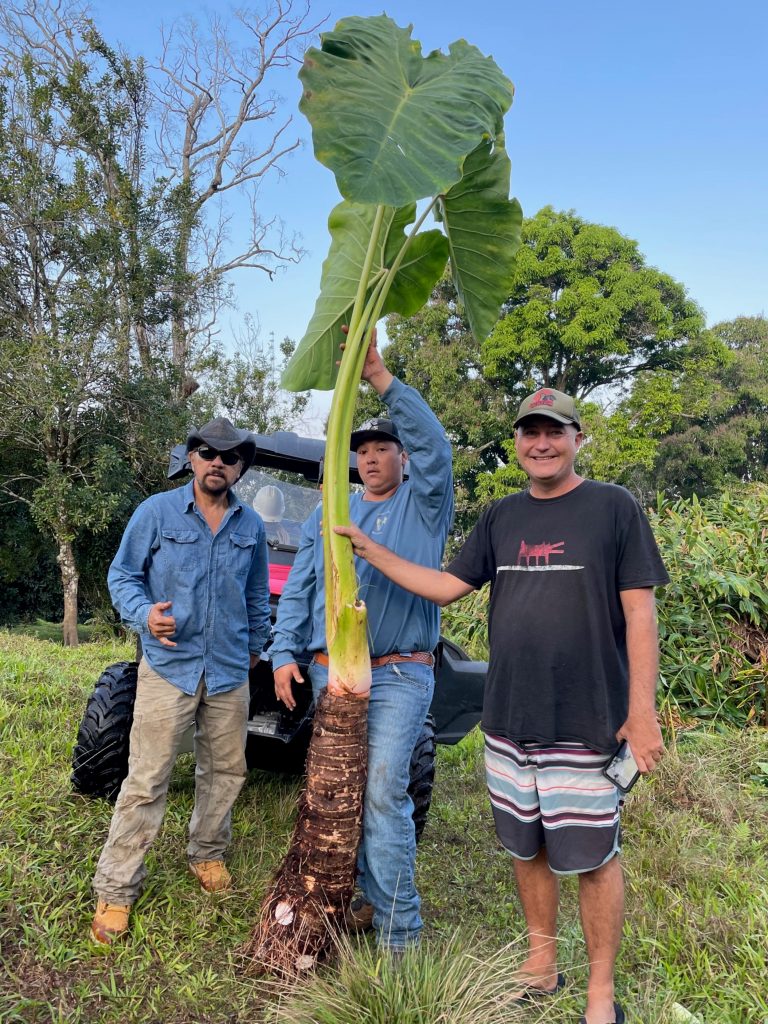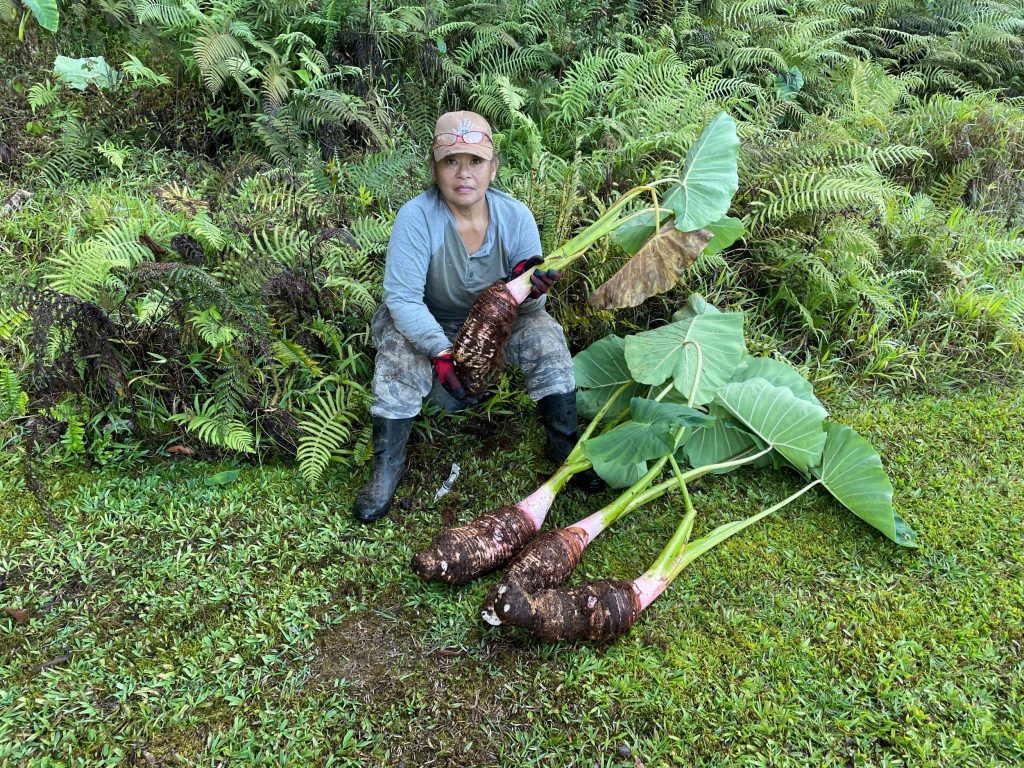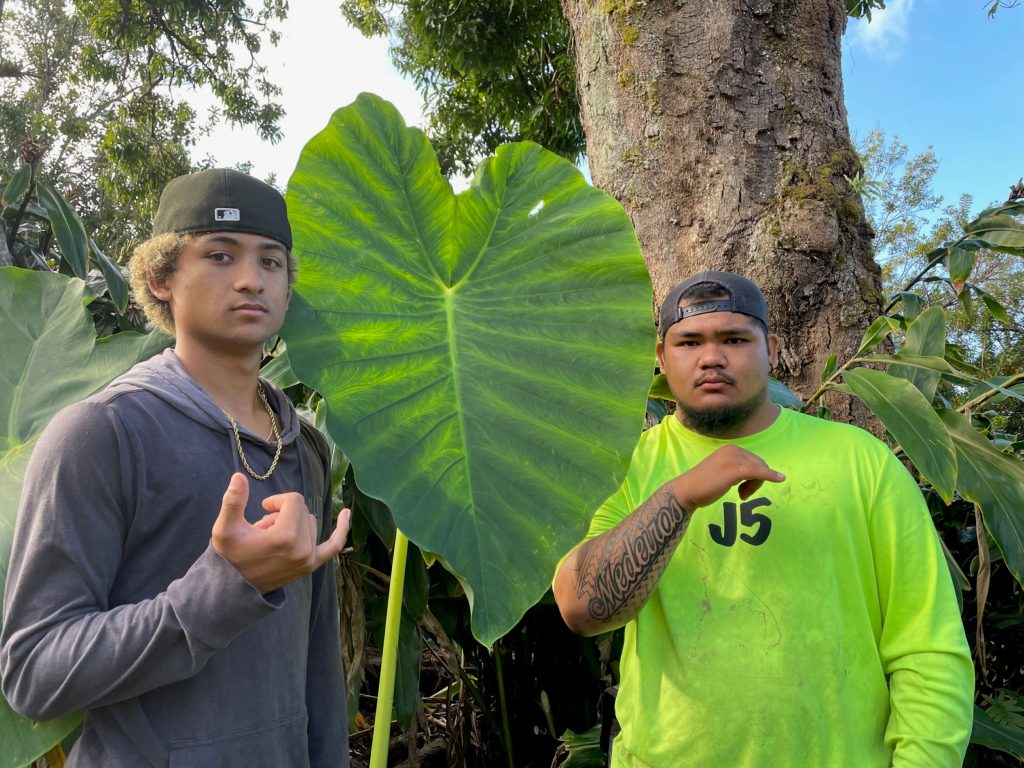Clarence and the colossal kalo: Big Island farmer grows world-record 50-pounder

Seventy-one-year-old Clarence Medeiros Jr. has plucked many plump kalo, or taro, on his farm in South Kona. It’s not out of the ordinary for him to harvest corms, the fleshy underground stems of kalo plants, that weigh up to 25 pounds.
In 2021, he broke the ‘o‘o bar he was using to pull a whopping 33-pounder out of the ground.
But a year later, he and his grandson Lincoln Medeiros unearthed the most colossal corm either of them — and it turns out the rest of the world — had ever seen.
The 50-pound kalo corm they harvested on Presidents’ Day, Feb. 21, 2022, was recently certified by the Guinness Book of World Records as the official heaviest to be recorded on the planet.
The king-sized kalo put to shame the previous world record holder, a 7-pound corm harvested in 2009 in China. The average size of a taro plant depends on the variety, but the U.S. Department of Agriculture says they usually weigh in at 1 to 2 pounds.
The world record plant was at least 11 feet tall, from the top of its leaves to the bottom of the corm. It dwarfed Medeiros as he stood holding it after the hefty harvest.
The entire kalo plant — which included the leaves, corm, stock and eight keiki of 8 to 12 pounds each — weighed more than 100 pounds.
“I was gonna do it by myself, but lucky thing I wait because this bugger was bigger than I thought it was,” Clarence Medeiros said.
It could feed about 180 people.
And, with the the taro content of store-bought poi at about 30%, it would have made just shy of 15 pounds of the cooked, mashed and fermented Hawaiian favorite.
“When we went home and put it on our scale and it came out at 50, we’re looking at each other like, whoa,” said Medeiros’ wife Nellie, who was with her husband, grandson and Hawai‘i ‘Ulu Cooperative Honalo facility manager Holokai Brown when the plant was harvested.
After doing some research and learning about the previous record, Brown suggested submitting the gigantic plant to Guinness.
Medeiros is a member of the Hawai‘i ‘Ulu Co-op. He sells his produce to be processed and sold by the 7-year-old cooperative, which has aggregated more than 1.5 million pounds of Hawai‘i-grown staple crops such as kalo since it started. The co-op partners with The Nature Conservancy to promote agroforestry in the islands.
The co-op took charge of contacting Guinness and the rigorous certification process, which included the plant’s measurements having to be verified by the state and signed-off by a certified horticulturist. Medeiros also had to complete several documentation forms and submit photos and videos from the harvest.

“It’s a blessing,” Medeiros said about the world record now being held by Kona, Hawai‘i and America, especially when there are other countries that plant and produce metric tons of taro but have never registered anything that large. “I think it’s kind of special.”
Nellie Medeiros added: “We’re just so proud that we can bring that to Hawai‘i and to Kona because there’s no place like home and like Kona and no place like Hawai‘i Island.”
Clarence Medeiros learned the art of cultivating kalo from his father and grandfather — and has operated his own farm for the past 50 years.
His operation now encompasses a total of about 33 acres and includes a variety of crops including kalo, macadamia nuts, breadfruit, avocados and Maoli Heritage Coffee. He has four parcels where he grows kalo that equal a total of about a half-acre.
The maintained fertile black soil trail where the 50-pound kalo was grown is about a mile from his home in a forested area at a slightly cooler elevation of 1,600 feet. Ferns, ginger and other plant material not only help keep the ground moist but also deter predators that can damage the taro.
Medeiros uses sustainable farming and traditional agroforestry practices. He grew the world-record kalo without using fertilizer and relying solely on rainwater. His approach is rooted in practical, low-impact methods and letting nature do its work.
He said less vog and acid rain during the past few years also has helped his taro thrive.
Medeiros can trace his Native Hawaiian lineage back to two of Kamehameha the Great’s chief counselors. He’s also a direct descendant of Don Francisco de Paula Marin, who is known for introducing coffee plants to Hawai‘i in 1813.
His family for generations has grown kalo in South Kona. He started helping his grandparents and parents when he was about 6 years old, as soon as he could put on his own rubber boots. He’s now teaching his own grandchildren.
When his father was in the hospital during the last days of his life, he shared some wisdom with his son.
“The last words out of his mouth was, ‘Love your God, take care of your family, keep the huli,'” Medeiros said.
Huli are the shoots at the bottom of the corm, the keiki, that can be planted after kalo is harvested that will grow into another plant.
He shares his huli with his three grandsons, who also all help him on the farm.
Nellie Medeiros said her father-in-law’s last words live on in her husband.
“He’s followed all of that,” she said. “I am thankful that he is passing on to our grandchildren the family virtues, practices and traditions that was passed on to him.”

























